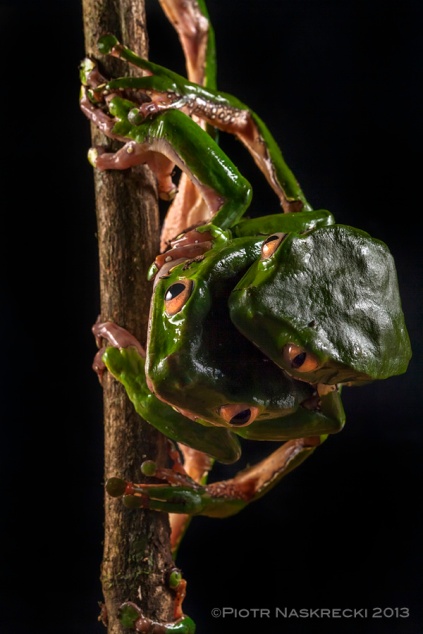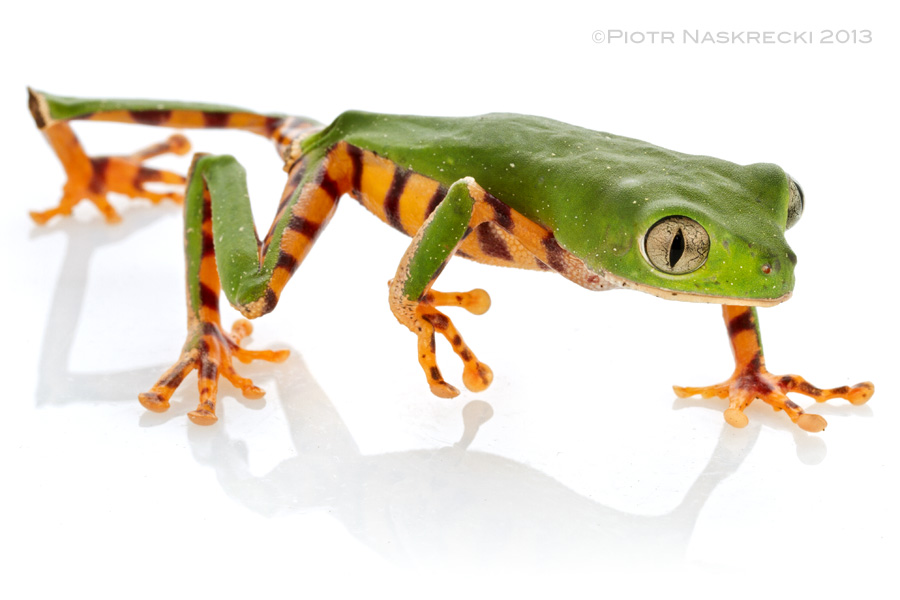
It may seem counterintuitive, but many small, cryptic animals, those that blend perfectly into their environment, are much easier to find at night than during the day. Katydids, walking sticks, snakes – these animals usually spend their days absolutely still, but at night they feed and court, making their presence known through their movement. Others, including moths and spiders, can be spotted at nigh by their eyeshine, reflected in the light of a headlamp. Over the years I have learned how to recognize some of the animals by the color and size of the glow of their eyes. For example, small green eyeshine in the grass – lycosid spiders, large green in the savanna – antelopes (or cats), small orange in a tree – moths, large orange in the water – crocodiles etc. It goes without saying that the eyeshine always occurs in twos (even eight-eyed spiders display eyeshine only in their two largest eyes), or as single eyeshine, when the animal is not facing the viewer.
I was therefore quite confused when during a night walk in the rainforest of Suriname a few years ago I spotted four, large and brightly glowing orange eyes in a tree in a distance. They were moving in unison, clearly attached to one body, and by their diameter and spacing I figured that the animal had to be at least the size of a large rat. I had to find out what it was.

Of course, once I got closer and was able to put the spotlight on the entire animal, the truth turned out to be somewhat less exciting than a four-eyed chimera, but interesting nonetheless. The strange creature was a pair of Giant leaf frogs (Phyllomedusa bicolor) in amplexus – the male firmly gripping a much larger female – moving slowly towards a branch overhanging a stream, where the female clearly intended to lay her eggs. As their name implies, these frogs are huge. I am not absolutely sure, but I believe that they might be the largest tree frogs in the world, easily reaching the length of 5 inches or so. Like other members of the genus Phyllomedusa they spend their life in the trees, and lay egg clutches on leaves overhanging forest streams or other small bodies of water.

And indeed, in the morning I found a fresh clutch of eggs glued to leaves over the stream. The two animals were still hanging nearby, the female noticeably thinner than the night before. I took some photos of the pair, all along wondering if I should try to lick them. In the end the smaller, more responsible part of my brain prevailed, but to this day I am curious what would have happened.
The skin of Phyllomedusa bicolor (“Sapo”) is full of potent peptides, such as phyllocaerulin, phyllomedusin, and dermorphins, all of which have incredibly powerful effect on humans. On smaller animals, such as rodents, the effect is simple – it kills them. But to something the size of a man the same compounds are not lethal. Rather, after an initial, very unpleasant reaction that includes violent vomiting and passing out, you apparently wake up refreshed, much stronger, resistant to hunger and thirst, and with heightened senses and the ability to cope with stress. The Matsés Indians of Peru and Brazil have known that for a long time, and they routinely use the extract of the Sapo skin before hunting expeditions. Unfortunately, the delivery method of the extract does not sound very pleasant, to either the man or the beast – they first burn their own skin, then peel it off (!), and only then rub in the extract, which has been obtained by, essentially, torturing the poor frog for three days. (The entire process is described in excruciating detail in a paper by Erspamer et al. 1993. Toxicon 31: 1099-1111.)

But helping people get high is not the only reason why Phyllomedusa frogs have evolved this amazing pharmacopeia. I did a quick search on MEDLINE and found 167 research papers on various compounds present in their skin, including both those that serve as predator repellents (e.g., alkaloids, quinones), and a vast array of antimicrobial, antifungal, antiviral, and even cancer-suppressing peptides. These may lead to the development of new treatments for assorted ailments afflicting the humankind, and hopefully means that sooner or later I will be able to experience the positive effects of the “sapo” without having to peel off my singed skin.


The male in the first photo really looks sinister. Probably the “evil eye” he gives to other males that might try to interfere with his amplexus.
I was absolutely amazed the first time I went out in the Amazon jungle at night. It seemed like everywhere I pointed my flashlight there was some wonderful small critter to photograph. I actually felt a little stressed because I didn’t know where to start! LOL! Excellent post as always…
Very beautiful. We had a large male in our camp in French Guiana in some small Cecropias. It seemed a bit confused, as he was calling every night, but was pretty far from the water. They really are spectacular frogs.
Reblogged this on Mark Solock Blog.
Wow, very cool…sounds like they turn you into Wolverine…